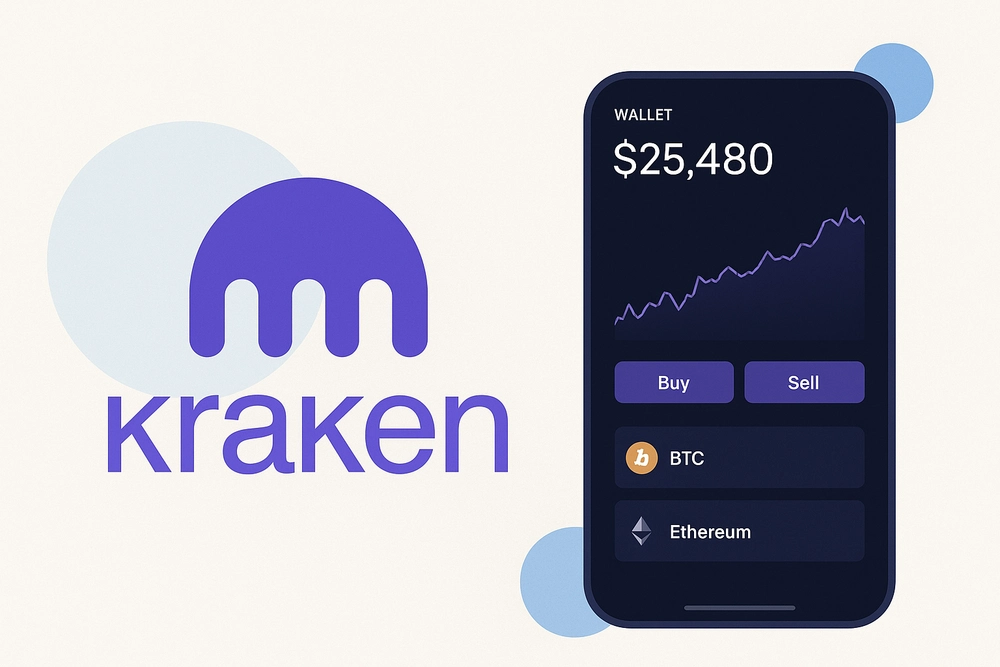Kraken remains one of the longest-running and most trusted U.S. cryptocurrency exchanges in 2025. Founded in 2011, Kraken has built a reputation on security and regulatory compliance.
Recent milestones underscore its strong position: in early 2025 the SEC dropped its enforcement case against Kraken with prejudice, and Kraken reinstated on-chain staking for U.S. customers (supporting networks like Ethereum, Solana, Polkadot, Cardano).
Kraken supports hundreds of coins (over 500) and multiple fiat currencies (USD, EUR, GBP). The platform is licensed in the U.S. (except Maine and New York) and holds a MiCA license in the EU, giving American investors broad access under clear rules. With mobile apps (rated ~4.7/5 on iOS) and a powerful “Kraken Pro” interface, Kraken competes head-to-head with Coinbase, Binance US, and Gemini by offering advanced trading tools, staking rewards, and institutional-grade features.

Key Features and Benefits
- Wide Crypto Selection: Kraken supports 500+ cryptocurrencies and 1,200+ trading pairs. All major coins (Bitcoin, Ethereum, Cardano, Solana, etc.) are available, plus many altcoins and stablecoins. Kraken’s live catalog is continually updated.
- Advanced Trading Platform: Kraken offers two interfaces. Instant Buy lets beginners purchase crypto quickly, while Kraken Pro provides an exchange-style order book with deep liquidity, advanced order types, charting, and margin/futures trading. Margin up to 5–10× is available on many spot markets, and Kraken offers 300+ perpetual futures (up to 50× leverage) on major coins. In 2025 Kraken expanded its professional suite by acquiring NinjaTrader and a U.S. derivatives platform, bolstering tools for active and institutional traders.
- High Security & Transparency: Security is a cornerstone of Kraken’s design. Over 90% of customer funds are held in cold, offline storage. Kraken is ISO 27001 certified and undergoes SOC 1/SOC 2 audits. It employs phishing-resistant 2FA (including FIDO2 security keys and passkeys) and withdrawal allowlists. Notably, Kraken publishes Proof-of-Reserves every quarter, allowing users to cryptographically verify that the exchange holds one-to-one backing for customer funds. (In June 2024, Kraken’s security team swiftly fixed a reported vulnerability that accessed company funds, confirming no customer assets were at risk.)
- Staking Rewards: Kraken offers on-chain staking for dozens of proof-of-stake coins. Customers can earn up to ~21–22% APY on selected assets through flexible (unstaked anytime) or bonded (higher-yield locked) staking options. Supported staking assets include Ether, Cardano, Solana, Polkadot, Cosmos, Polygon, and many others. Kraken also supports innovative services like Ethereum restaking (through EigenLayer) and BTC staking via Babylon protocol. Staking rewards are paid weekly and users retain full custody of their coins while earning yield. As of Jan 2025, on-chain staking is once again available to U.S. clients (in eligible states) for ETH, ADA, SOL, DOT, etc..
- Fiat On-Ramps & Funding: U.S. investors can fund Kraken via ACH bank transfers (free), Fedwire ($4), and SWIFT (often free inbound). USD and other fiat (EUR, GBP) are fully supported. Kraken also accepts credit/debit card purchases (at ~3.75% fee) and stablecoin deposits. Fiat withdrawals include free ACH and low-cost wires/Swift. In contrast to some exchanges that paused banking (Binance.US suspended USD rails in 2023), Kraken has always maintained broad fiat support for U.S. users.
- Institutional Services: Kraken Prime and Kraken Institutional offer custody, OTC trading, white-glove support, tax reporting, and advanced APIs. With acquisitions like NinjaTrader and Small Exchange, Kraken is expanding multi-asset custody and regulated futures for professional traders. The exchange’s Q2 2025 results showed strong growth (~$412M revenue, +18% YoY), reflecting rising institutional interest.
- User Experience & Support: Kraken’s web and mobile apps present market data and account info clearly. The interface is more sophisticated than some simpler apps, which can benefit active traders but may have a learning curve for novices. Kraken offers 24/7 live chat and email support, though user reviews note occasional delays or verification backlogs. The Kraken mobile app is highly rated (4.7/5 on iOS) for its intuitive layout and features.
Pros and Cons of Kraken
- Pros:
- Security & Trust: Top-tier security (ISO 27001, SOC2) and public Proof-of-Reserves. Strong track record (no loss of customer funds from hacks).
- Wide Offerings: 500+ cryptos, margin and futures trading, staking up to ~21% APY, and institutional services.
- Regulatory Compliance: Fully licensed in U.S. (FinCEN-registered MSB) and EU (MiCA). Full KYC/AML and soon IRS 1099 tax reporting (see below).
- Fiat Support: Free ACH USD deposits/withdrawals, plus EUR/GBP via SEPA/Faster Payments, etc.. Instant buys available in app.
- Customer Service: 24/7 support channels with detailed online knowledge base.
- Cons:
- Fees: Standard trading fees (0.25% maker / 0.40% taker) are higher than some rivals (see table below). Instant buy/sell spreads and crypto-conversion fees can be relatively expensive.
- Learning Curve: Two platforms (Instant and Pro) and advanced features can overwhelm beginners. Kraken is generally geared to more serious traders than casual “one-click” apps.
- Limited U.S. Access: Not available to residents of Maine or New York. (Gemini, by comparison, is headquartered in NY but licensed to operate nationally; Coinbase is nationwide.)
- Mixed Reviews: Trustpilot scores are low (Kraken ~1.5/5) with complaints about KYC delays and fee confusion. (However, App Store reviews are strong, and many complaints reflect temporary issues.)
- Product Gaps: Kraken has closed its NFT marketplace (ended Feb 2025), so no NFT trading. Some DeFi services (like non-custodial wallets) are not a focus.
Also read: NFT Games: A New Frontier in the Gaming Industry
Kraken vs. Coinbase, Binance US, and Gemini
The table below summarizes how Kraken compares on key dimensions. Data and features are current as of 2025.
| Feature / Exchange | Kraken | Coinbase | Binance US | Gemini |
|---|---|---|---|---|
| Trading Fees (maker/taker) | 0.25% / 0.40% (base; volume discounts apply) | 0.40% / 0.60% (base on Coinbase Advanced) | 0% / 0.01% on ~20 “Tier 0” pairs (e.g. BTC, ETH) | 0.20% / 0.40% (ActiveTrader base: high-volume tiers go lower) |
| Security & Reg. | ISO 27001, SOC2; 95% cold storage; Proof-of-Reserves; licensed U.S. (excl. ME,NY) & EU | SOC2; Bitcoin insurance fund (~$255M) on exchange assets; FDIC-insured USD up to $250k | Complies with U.S. regs (BAM Trading); uses Binance’s SAFU insurance fund | SOC1/SOC2; NYDFS-regulated; FDIC-insured USD; audits (Gemini Trust) |
| Coins Supported | 526+ (global ~560) | Hundreds of coins (~250–300) | ~160 cryptocurrencies | ~70+ cryptocurrencies (focus on top coins) |
| Staking / Yields | On-chain staking for ETH, ADA, SOL, DOT, etc. (U.S. eligible); up to ~21% | Supports ETH, ADA, SOL, etc. staking (≈4–5% on ETH) | Staking for 20+ assets (e.g. ETH, ADA, DOT) with competitive yields | Staking on multiple coins (e.g. ETH, ADA); ~5% max rewards |
| Interface / UX | Instant Buy (simple) + Kraken Pro (advanced); customizable workspaces | Very beginner-friendly mobile and web app; advanced order book (Coinbase Advanced) | Basic app + advanced “Pro” mode; similar to Binance global UI | Easy web/mobile interface; “ActiveTrader” platform for pros; also NFT marketplace and crypto credit card |
| Customer Support | 24/7 live chat and email; global support center | 24/7 email/ticket and phone (for eligible accounts); large knowledge base | Email support; limited phone; plans to expand banking services | 24/7 support via phone/email; generally high marks for customer service |
| Fiat On-Ramps | USD/EUR/GBP via ACH, SEPA, Faster Payments; debit card | Bank (ACH/wire), credit/debit card; supports many fiat | USD (bank ACH paused through 2024; USD deposit/withdrawal resuming in 2025) | USD via ACH (free); debit/credit (3.99%); stablecoin conversions |
| Regulatory Notes | US FinCEN-registered; BitLicense not held (hence no NY service); MiCA-licensed (Ireland) in EU | US MSB; regulated globally; BitLicense in NY; recently 1099-DA reporting | US entity (BAM); SEC dismissed US case in 2025; resumes banking soon | NYDFS-licensed; FDIC-insured USD; actively audited and compliant |
Analysis: Kraken’s security and transparency stand out: unlike many exchanges, it offers public Proof-of-Reserves. Its fee schedule is mid-range – higher than Binance US’s new near-zero fees but lower than Coinbase’s base fees. Binance US, however, has severely constrained fiat rails through 2024 and only recently announced USD services will restart in 2025. Coinbase is the most beginner-friendly but charges higher fees; Kraken’s Instant Buy has no subscription fees but its on-book trades offer lower maker/taker rates. Gemini offers polished apps, FDIC-insured USD, and unique products (Gemini Earn, NFTs, Gemini Credit Card), but supports fewer tokens and higher trading fees than Kraken (0.20% maker vs Kraken’s 0.25%). In short, Kraken is highly competitive on U.S. regulatory compliance and advanced features, trading on par with (or beating) Coinbase for most active users, and catering to staking and institutional needs that Gemini and Binance US less fully address.
Also read: Crypto.com Review: Pros, Cons and How It Compares
U.S.-Specific Considerations
- Regulatory Compliance: Kraken is licensed as a Money Services Business in the U.S. and complies with federal/state laws. It requires full KYC verification for all customers. Unlike Coinbase and Gemini (which hold New York licenses), Kraken’s U.S. entity deliberately avoids New York and Maine. This means residents of those states must use alternatives. Kraken aligns with IRS guidance: starting January 2026 it will issue IRS Form 1099-DA to report 2025 crypto gains. (Currently Kraken does not produce 1099s, but will comply with newly finalized IRS rules. All crypto trades on Kraken are taxable events in the U.S. as capital gains or income.)
- Fiat Funding & Transfers: U.S. customers can link bank accounts (via Plaid) for free ACH transfers in/out. FedWire transfers are also supported (small fees apply). Kraken does not charge markups on fiat deposits. By contrast, Binance.US halted USD banking in 2023 (amid regulatory scrutiny) but plans to resume ACH/USD services in early 2025. Coinbase and Gemini both continue to offer robust USD on-ramps (ACH and wires), with Coinbase additionally supporting many global fiat pairs.
- Tax Reporting: Kraken provides extensive transaction history and 1099 forms for clients who qualify. As noted, beginning with the 2025 tax year, Kraken will issue Form 1099-DA for U.S. customers. Other U.S. exchanges also comply (Coinbase and Gemini issue 1099-K/1099-B or 1099-DA where required). Kraken’s account interface makes it easy to export trade and staking income reports for tax software.
- Customer Service and Education: Kraken’s support center offers guides on U.S. crypto taxes and trading. Its Crypto Tax Guide (for 2025) details IRS regulations, reaffirming that Kraken will align with the latest rules. Retail investors can reach Kraken’s 24/7 support team anytime, though response times vary. Kraken does not impose country-based restrictions beyond the stated state bans.
Final Verdict: Who Is Kraken Best For in 2025?
Kraken is well-suited for security-conscious and professional crypto users. Long-term investors will appreciate Kraken’s transparent Proof-of-Reserves, regulatory clarity, and staking opportunities (earning up to ≈20% APY on major coins). Active and institutional traders gain from Kraken Pro’s advanced orders, deep liquidity, and added tools like futures and OTC trading. With Kraken Prime, high-net-worth and corporate clients get dedicated support and reporting.
In contrast, complete beginners or ultra-casual users might prefer a more streamlined app (e.g. Coinbase’s guided interface) or lower fee passive buys (e.g. Binance.US’s 0.01% taker fees). Anyone in Maine or New York cannot use Kraken, and those prioritizing only the lowest fees on small spot purchases might look elsewhere.
Overall, Kraken shines when security, control, and broad functionality are priorities. As of 2025, it remains a top choice for U.S. crypto investors who value institutional-grade trust signals and a full-featured trading platform over bare-bones simplicity.
Also read: Best Crypto Futures Exchanges for U.S. Traders
FAQ
Is Kraken safe?
Yes. Kraken employs industry-leading security: most funds are offline (cold storage), it has ISO 27001 and SOC 2 certifications, and it uses strong user safeguards (FIDO2 keys, allowlists, etc.). It publishes quarterly Proof-of-Reserves so you can verify the exchange holds your assets one-to-one. Kraken has never lost customer funds to a hack. In 2024 a security researcher identified and withdrew company (not customer) funds via a bug, which Kraken patched immediately with no client impact. These practices make Kraken among the safest U.S. exchanges.
What are Kraken’s fees?
Kraken’s standard trading fees (Kraken Pro) start at 0.25% maker / 0.40% taker for low volumes. Fees scale down with 30-day trading volume or via “Kraken+” subscription. Deposits are mostly free: ACH transfers in/out are free, Fedwire withdrawals ~$4. Kraken’s fees are lower than Coinbase’s base fees (Coinbase Advanced is 0.40%/0.60%), but higher than Binance.US’s ultra-low rates (0%/0.01% on many pairs). Instant-buy or crypto-conversion fees on Kraken tend to be higher than maker/taker rates, so advanced orders on Pro are cheapest for big trades.
How does Kraken compare to Coinbase?
Coinbase is generally more beginner-friendly: it has an intuitive interface and seamless bank integration for U.S. users. By contrast, Kraken’s interface is more “pro” in style (with an Instant Buy for simplicity and a full Order Book for traders). The big difference is fees and transparency: Kraken’s base fees (0.25%/0.40%) are lower than Coinbase’s (0.40%/0.60%). Coinbase, however, offers things like a Visa debit card, easy staking via Coinbase One, and broader fiat on-ramps. Crucially, Kraken publishes Proof-of-Reserves, whereas Coinbase provides insurance coverage; each has strong security. In summary, use Coinbase if you want the simplest on-ramp; use Kraken if you want lower trading fees and public reserve attestations.
Can I stake crypto on Kraken?
Yes. Kraken supports staking for many proof-of-stake coins. U.S. customers (in eligible states) can stake Ethereum, Cardano (ADA), Solana, Polkadot, and others on-chain. Kraken offers both flexible staking (withdraw anytime) and locked staking (higher APY). Current staking rates can reach ~10–20% on certain tokens (for example, Tezos and Cosmos up to ~18%–22% at times). Rewards are paid out weekly. Kraken’s staking is comparable to Coinbase’s for major coins (Coinbase pays ~4–5% on ETH, for example), and generally more options than Gemini (Gemini’s yields cap around 5%).
Who can use Kraken in the U.S.?
Kraken is available to U.S. residents except those living in Maine or New York. All other states (and U.S. territories) can sign up, complete KYC, and trade. It is legal and licensed in the U.S. Investors should note the available services may vary by state (e.g. some altcoins or staking may be restricted). If you relocate, Kraken’s “Global Availability” page clarifies current offerings by region.






